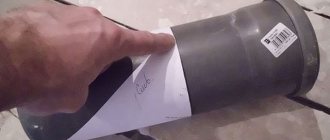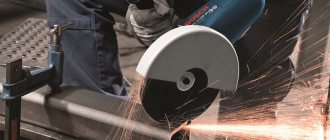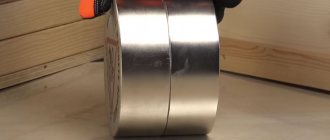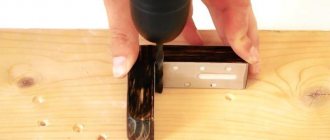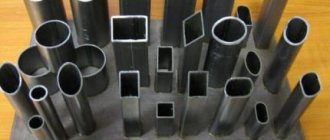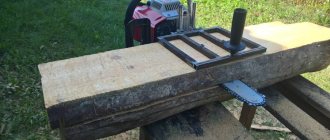How to quickly learn how to weld a ceiling seam with an electrode
Many welders do not like to weld ceiling seams, since this is the most uncomfortable and difficult position in welding. However, if you need to master the professional knowledge of a welder, you will have to weld ceiling seams one way or another.
Moreover, without welding vertical joints it is impossible to perform a number of certain works. Fixed pipe joints or upper elements of a metal frame require a ceiling seam.
How to weld ceiling seams and what you should know? Is it possible to quickly master the technique of welding ceiling seams on your own?
We measure
The first method is not entirely convenient, but quite accurate. Suitable if you are “in the tundra” and have nothing at hand except a pencil and tape measure. I had to use it a couple of times. The diameter of the pipes does not matter.
An important condition is the presence of a flat plane near the cut. This could be the edge of a pipe, a socket, a put-on or welded-on coupling, a seam, or any other concentric circle.
We mark the place of the cut with a risk. We measure the distance from the mark to a flat plane. We rearrange the tape measure along it and make risks in a circle, using the given size. We get a circle from the marks.
Preparing river sand for do-it-yourself sandblasting
Preparing river sand for do-it-yourself sandblasting
THE MOST COMMON CASE IN PRACTICE IS THAT IT IS NECESSARY TO CLEAN A LARGE METAL STRUCTURE OR WALLS OF PAINT AND RUST FROM A LARGE METAL STRUCTURE OR WALLS FOR REGULAR PAINTING. ORDINARY, INEXPENSIVE, NOT FRACTIONATED RIVER SAND IS SUITABLE HERE. THE MAIN THING IS TO SIFT AND DRY IT CAREFULLY BEFORE LOADING. ALLOWABLE HUMIDITY – THE SAND SHOULD FLOWS FREELY WHEN COMPRESSED IN YOUR FIST. IN ADDITION, ITS FRACTION MUST SUITABLE TO THE SIZE OF THE NOZZLE. WORK SHOULD BE CARRIED OUT AWAY FROM RESIDENCE OR IN A SEALED ROOM WITH DUST SUPPRESSION MEANS.
We crimp
A method widely replicated on the Internet. Take a sheet of paper or newspaper. We wrap the pipe so that the edges meet at one point. The edge of the newspaper is the cutting plane. We draw with a pencil or marker - the marking is ready.
I don’t see any restrictions on pipe diameter here. The only question is what to take for wrapping. Rolled paper (for example, fax) is suitable for marking new large-diameter pipes. For old rusty pipes, we made clamps from steel tape about fifteen centimeters wide.
The materials can be different: masking tape, roll of sandpaper, roll of penofol, etc. The denser and wider the tape, the more accurate the markings.
Let's spin
The method I most often use when trimming small diameter pipes.
I place the pipe against the wall, resting its free end against a corner (if necessary, I put something under it to prevent the pipe from rolling away). At the place of the cut, I touch the pipe with a pencil or marker. To keep my hand from shaking, I rest it on the wall. I rotate the pipe by the edge, and the pencil outlines an even cutting line.
It may seem that the method is only suitable for small pipes. Once we managed to mark a pipe just over a meter in diameter.
Once they brought to the workshop a pipe three meters long and something about twenty meters in diameter, I don’t remember exactly. They told me to cut it off. Frankly speaking, this is a non-standard task for us. But we managed.
After a brainstorming session, we drove to a carpenter and brought in a factory-made sheet of plywood. One side was placed tightly under the pipe (at an angle to the future cutting line). A line was drawn along the second side along the floor - this is a perpendicular.
Then everything is as described above, only on a large scale. Two men rolled the pipe, trying to do it as evenly as possible. The third placed a marker on the pipe and guided it along the line marked on the floor. At the end, the marking closed, which means we succeeded. There are no unsolvable problems. You just need to be smart.
That's all for me. Thank you for reading. If the article was useful, subscribe to the channel
and, of course, give it a thumbs up.
45 degree cutting
One particular example of such a situation is the need to cut a metal pipe at an angle of 45 degrees. Such cutting of material is often required when laying water pipes or heating systems. In this case, you have to deal with steel pipes. For these purposes, conventional cylindrical pipes are usually used. If we are talking about the installation of some kind of metal structures, then profile pipes of rectangular or square cross-section are more often used. The main problem here is that in order for the elements to be connected to coincide, the cut must be as smooth as possible, which means that especially close attention should be paid to marking the material.
In cases where cutting at an angle is required, a simple square sheet of paper can be used as a marking template. It must be folded strictly diagonally, and then wrapped around the pipe with the template. In this case, it is necessary to carefully ensure that the side of the sheet, which is located closer to the end of the pipe, is perpendicular to its central axis. Next, using marking material, a series of dotted lines is applied and after the marking is completed along the entire circumference, the template can be removed.
If you have to cut a profile pipe, then it is advisable to make a special template from the same pipe, but with a larger cross-section. In this case, you will only have to use the measuring devices once. To apply markings you will need to use a protractor or a construction square. After sawing off the template, the pipes to be cut can simply be inserted into it and marked. This approach will significantly save work time and cutting a profile pipe at 45 degrees will be convenient.
As for what to use when carrying out work, you should choose the most suitable and familiar one. This can be a simple hacksaw for metal, or a grinder with an installed cutting disc.
What sand is suitable for a sandblaster?
In the 19th century, during the period of active creation and implementation of metal structures, it was necessary to clean the metal from rust before applying the coating. A pneumatic device - sandblasting - has proven itself well in this sense - it ejects abrasive material from the nozzle at high speed (300-800 km/h or more).
In the mid-20th century, new abrasives began to be actively invented and used. Today, there are many types of consumables for sandblasting machines on the market. This article is intended to help the buyer navigate this diversity and figure out which sand for sandblasting should be chosen in a given situation.
- 1 How to choose the right sand for a sandblasting gun?
- 2 How to choose the right sand for sandblasting?
- 3 Cleaning solid external surfaces with quartz sand
- 4 Consumption of quartz sand during sandblasting
- 5 Preparation of river sand used for do-it-yourself sandblasting
- 6 How to sift sand for sandblasting
- 7 How to dry sand for sandblasting
- 8 Where to get sand for sandblasting
How to cut a profile pipe evenly
You can cut a profile pipe in much the same way, but here it will be easier to use a square. The device is applied to each side in turn, for which the element to be cut will need to be rotated, and markings are applied. Next, the pipe must be secured firmly and work can begin.
Any suitable tool can be used for sawing. If you have to cut a lot of pipes, then it is advisable to make full-fledged templates from scraps. In this case, measuring and marking work will have to be done only once.
Hacksaw or back saw.
A hacksaw or back saw is the most common method for cutting PVC pipe because many people already have one of these in their toolbox or garage. A hacksaw or back saw can work fine, but they can take a long time and may require additional work to remove burrs from the edge of cut PVC pipes. A hacksaw or back saw is the ideal tool
, if you need to cut only a single or several pieces of pipe at the same time. Back saws generally come with a miter box and you can use them together to make a straight cut.
conclusions
Many private households have gasoline saws, as well as light boats. If for some reason the standard outboard motor has failed or has not yet been purchased, you can make a worthy replacement from an existing chainsaw. A simple tool, technical knowledge and a homemade boat motor are ready.
The advantages include low cost design, the ability to use any chainsaw and high maintainability. It is very convenient that the design is modular and does not entail changes to the standard design of the chainsaw. If necessary, the engine is removed from the outboard motor, the guide bar and chain are returned to it, and the chainsaw can again do its job.
Many people living near bodies of water require a boat motor. However, most outboard engines are quite expensive, which makes them inaccessible to the majority of the population. In this case, the best option would be to independently assemble a boat motor from a chainsaw. This design is easy to use and maintain. In addition, a motor for a boat made from a chainsaw consumes an order of magnitude less fuel. These and many other advantages make a homemade unit a reliable assistant for every fishing enthusiast.
Pipe cutter with ratchets.
A power saw is indispensable for cutting large quantities of PVC pipes. A power saw, however, is an expensive piece of equipment. If you have the only one or you have access to it
, and you can learn how to use it completely safely, you can use an affordable wooden blade to cut PVC pipes without purchasing a special blade. You should definitely read and understand the instructions that come with your miter saws.
As you can see, there are many very simple ways to cut PVC pipe. Therefore, choose the one that suits your liking.
High-quality cutting of polypropylene pipes
Due to the growing popularity and prevalence of pipes made of polypropylene (propylene polymer), used for arranging water supply systems and other communications, the demand for specialized tools that make working with the material has increased significantly.
Special, exceptional attention is paid to the correct choice of scissors model for cutting polypropylene pipe products. This greatly simplifies the preparation of the entire set of parts for wiring installation.
As a rule, straight sections (up to 12.0 m) are sold on the market, although polypropylene pipes in coils are often found, used for installing underfloor heating systems.
Boat motor made from a chainsaw
Boat owners are familiar with the problem of getting to their destination quickly or without physical effort. With a motor, this can be done much faster than rowing with oars yourself. It is quite possible to buy a suitable unit on the market, especially since there are now a huge number of offers. But an obstacle to this may be the high cost of factory boat engines. Therefore, boat owners are trying to get out of the situation using homemade products converted from chainsaws.
The idea of using a chainsaw engine instead of a boat motor became a reality with the advent of garden tools on the market with enough power to propel a boat fairly quickly through the water. The advantage of such an attachment is its low cost, the ability to use a used motor and the decent speed that the boat can develop.
Ratchet Pipe Cutter
Pipe cutter
The power saw is ideal for cutting large quantities of PVC pipes. Power saws, however, are expensive. If you already have one or have access to one and know how to use it safely, you can use an existing wooden blade to cut PVC pipe without purchasing a special blade. Be sure to read and understand the instructions that came with your miter saw.
The nuances of working with a rectangular section
Rectangular workpieces are much easier to cut lengthwise and crosswise at any angles than cylindrical elements, which are difficult to hold stationary on a flat surface. Transverse cutting of workpieces at any angle does not present any particular difficulties - the line of the required angular slope is drawn on the side edge and always coincides with the calculated one (round elements require the use of special patterns, calculated on a computer, to align their edges at an angle other than a straight line).
The thickness of the walls of a metal profile when used in households rarely exceeds 5 mm - it is easy to cut using an angle grinder with any metal disc.
Rice. 2 Types of transverse marking methods
Paper pattern for pipe
Using a paper sheet is a simple method of marking a rectangular or square profile for precise cutting at an angle of 90 or 45 degrees towards its axis.
To make markings for cross cutting at an angle of 90 degrees, take a sheet of paper and wrap it around the pipe until the edges line up exactly, after which they are glued together. With this method, the cutting line is very clearly visible, unlike drawing it with a pencil or marker along the edge of the template.
After this, the profile is cut along the template edge alternately from all sides, trying to avoid complete cutting of the finishing sections - this can lead to the disk hitting sharp corners and its destruction.
A sheet of paper can also be used to mark the side walls of rectangular or square pipes. To do this, the paper sheet is folded diagonally, and the resulting 45-degree angle is applied to the side walls and the appropriate markings are made. To ensure that the side lines are at the same level, an acute angle is applied to the transverse line placed at an angle of 90 degrees to the axis, which is previously applied in the above manner.
Rice. 3 Using a steel template
Miter box for cutting pipes
It is very convenient to cut a profile pipe using a special template, which is an analogue of a construction miter box for cutting building materials at different angles.
To do this, using the above or another method, a metal template is made from a piece of profile pipe cut along the length; it can be designed to obtain a right angle or an angle of 45 degrees.
To cut a metal profile, apply a template to it and draw a line with a scriber, along which a cut is then made. In other cases, the template is held and a grinder is used to draw a line along the surface of the workpiece, trying to avoid strong pressing of the side surface of the disk against the attached metal template. Then the template is removed and cutting continues along a clearly visible depression on the edges of the workpiece.
Using a template, you can get a very straight cut line if you do not hold it manually, but secure it to the workpiece using clamps or mounting bolts. To make your own fasteners, drill a hole in the side surface of the U-shaped plate of the template and weld a union nut at this point from the outside into which the bolt is screwed. To secure the template, place it on the part to be cut and screw in the bolt, pressing the template surface against the workpiece, then use a grinder with a metal disc to make a cut, lightly touching the guide edge.
Rice. 4 How to cut a workpiece with a homemade machine
Main stages of work
We weld a corner to the metal plate, placing it strictly in the center of the base. Along the edges of the corner you need to weld pieces of the pins on which the bearings will be located.
The author makes a small stand from pieces of studs and nuts. A homemade marker holder is attached to it. It can be made from a regular nut, in which you need to drill a hole for the fixing screw.
Next, a guide for an adjustable stop must be welded to the base of the device. To make an emphasis, the author welded a piece of metal plate to a round pipe.
We drill holes in the base for attaching the homemade product to the table. Then we paint all the parts and start assembling. We install a marker in the holder with which the marking will be made.
You can watch the video to see how to make a device for quickly marking round pipes. The idea was shared by the author of the YouTube channel Dr.Hacker.
Rate this post
[Votes: 10 Average rating: 3.8]
How to cut a cast iron pipe
If the pipe is made of cast iron, then in order to cut it smoothly you will have to apply certain knowledge. The fact is that this material is characterized by high fragility, which means that before cutting such a pipe, you need to determine an algorithm of actions.
- We mark in the same way as steel pipes.
- At the cutting site, you need to place a wooden beam as a support.
- Next you need to make a cut of a few millimeters around the entire circumference.
- After this, a chisel is inserted into the groove and a sharp and strong blow must be applied with a hammer.
As a result, it will split along the line, forming a fairly even cut area, which can be further processed if necessary.
How to cut lengthwise
Another frequently asked question is how to evenly cut a pipe lengthwise with a grinder. Here the algorithm of actions will be approximately the same as for transverse cutting. It is important to pay attention to marking. You can, for example, use painting thread, which is usually used when marking walls. In this case, it is necessary to firmly fix the pipe. The sawing process itself must be done carefully and slowly, since when sawing long elements there is a high probability of the cutting disc slipping from the marking line.
How to cut metal-plastic pipes
Metal-plastic pipes have a number of advantages over their competitors. They are much lighter than metal and much more resistant to oxidation than copper. They are easy to replace and easy to shape into the desired shape.
You can create a pipeline of any shape. Well, the main advantage is the cost. It is much lower than that of copper pipes. And the quality is approximately at the same level.
During operation, it may be necessary to cut pipes. For this, a special tool is used that is designed to work with such material.
To increase the effectiveness of the procedure, it is recommended to properly prepare the pipe and tools before work. Let's look at the main features of metal-plastic pipes and how to cut them.
Preparing the pipe and necessary tools
The tools used are the cutting device itself, measuring tapes, adjustable wrenches, seals and some other things. All this must be in an accessible place at the time of work.
Sometimes it is necessary to scrape the outside of the reinforced coating to make the cutting process easier in the next step. For stripping, a coupling with blades is used, which allows you to get a perfectly even cut and get rid of the polymer layer. This is necessary for welding work, which will most likely be carried out during pipeline installation.
Important! When working, it is necessary to cut off exactly as much material as is needed to attach the fitting for metal-plastic products.
Cleaning solid external surfaces with quartz sand
Cleaning solid external surfaces with quartz sand
Sandblasting metal with quartz sand is a type of cold abrasive treatment to remove secondary scale, burnt marks, rust and other contaminants. In addition, this method can be used to clean glass or stone, as well as to remove various coatings (enamel, galvanization, primer, etc.) from metal surfaces. The sand is moved by a directed air flow or a stream of water (in hydroblasting).
CLEANING STRENGTHENS SURFACES, INCREASES OPERATION LIFE AND QUALITATIVELY PREPARES FOR FURTHER APPLICATION OF COATINGS OR WELDING WORK. SANDBLASTING WITH QUARTZ SAND HAS ITS ADVANTAGES:
- thorough cleaning not only of scale, rust, old coating, but also of grease, which is extremely important for subsequent coating;
- increased adhesion (adhesion strength);
- versatility;
- economic benefit due to the low cost and availability of quartz sand.
Tools for cutting metal-plastic pipes
The following tools will be useful in the pipe cutting process:
It is important for the master to determine in advance what he will use to cut metal-plastic pipes. The most important tool on the list is scissors. Everything else is necessary for special preparatory work.
There is no need to apply much force during the cutting process. You just need to fully control every movement. If you do not pay due attention to control, you can easily cut off the excess part.
If during the cutting process it is necessary to bend the product, it is not recommended to do this by hand. This can easily damage the aluminum layer that is inside. It is better to take a professional pipe bender and perform the operation with its help.
Using the wrong tools on one area can affect the entire network, resulting in high repair costs.
Important! Special scissors are usually found in the welding kit. But they can be purchased separately. The price of this tool is not so high as to save on it.
Before you start cutting directly, you need to very clearly measure the part where the unit will be divided. To do this, use a tape measure or ruler, as well as a bright marker. A faded pencil may simply not be visible, especially if there is not enough lighting in the room. The mark can be made with a knife, leaving a scratch.
During operation, pieces of plastic and aluminum may fly in different directions. Therefore, it is necessary to use protective equipment in the form of glasses and special clothing.
Areas of application of various types of abrasive materials
If you have never encountered sandblasting and have not performed such an operation yourself, then to correctly select the consumables, you must use the following recommendations.
- To clean the metal surface or facade of a building from old coating and traces of corrosion, you can use pre-dried and sifted sand, which may not be divided into separate fractions.
- To add shine to products made of copper or aluminum, fine sand with a particle size within 0.3 mm is perfect.
- To remove old paintwork that adheres firmly to the base, it is better to use sand with a particle size of 0.3–0.6 mm.
- Entrenched traces of corrosion can be easily removed with sand, nickel and cooper slag with particle sizes of 0.6–1.6 mm.
- Using a coarse abrasive, traces of welding scale and thick bitumen coatings are removed.
- Automotive body parts that need to be cleaned and prepared for further painting are treated with steel or cast iron shot.
- Products made from hard metals (alloy steel, titanium, etc.) are processed using electrocorundum or garnet sand.
- Processing of ordinary glass (matting, application of drawings and patterns) is carried out using clean fine sand of a homogeneous fraction, tempered glass - using electrocorundum (particle size 0.1–0.8 mm).
- To process stainless steel products, stainless steel shot or small glass granules are also used.
Quartz sand VS-050-1 in 50 kg bags
Average prices for abrasives for sandblasting (data taken for Moscow and the region)
In conclusion, we suggest that you familiarize yourself with a couple of short videos that answer questions about where to get sand for your sandblasting machine and how to get it in proper shape before starting work.
Cutting technique
Self-cutting can be carried out with products with a diameter of 5 to 30 cm. So, if the product does not fall within these boundaries, it is best to turn to professionals.
When carrying out any such manipulations, it is important to remember the basic rules:
- Metal-plastic products are very sensitive to temperature, so some problems may arise in hot or cold weather. The material shrinks and expands easily, making it difficult to determine the true dimensions.
- Metal-plastic, like polypropylene pipes, can be cut with any available means. But in order to avoid various negative consequences, it is best to do this with special tools.
- An excellent tool is a special self-sharpening knife. But if you plan to carry out work to replace one section with another, it is better to abandon the tool in favor of scissors.
- The material is quite fragile. Applying too much force can result in cracks or specific deformations. The permissible load can be seen in the product passport, which was issued at the time of installation of the water supply system.
- The type of cutting directly depends on the proportion of metal and plastic in the product. If there is more metal, then when cutting there should be as little friction as possible. Otherwise, a large proportion of plastic means a higher intensity of work with high friction.
- Before starting work, you must make sure that there is no water or gas flowing through the pipe. You need to turn off all the taps and wait a little.
- After completing the work, you need to thoroughly clean the inside of any debris that could lead to blockages or break specialized equipment.
The use of electronic cutting tools is not considered reasonable, since the specific material is not designed for this. You can do it manually.
Consumption of quartz sand during sandblasting
Consumption of quartz sand during sandblasting
SAND CONSUMPTION IN EACH SPECIFIC CASE DEPENDS ON VARIOUS FACTORS: POWER OF THE SANDBLASTING MACHINE, VOLUME OF WORK, DEGREE OF BASE POLLUTION, SAND FRACTION, SIZE AND TECHNICAL CHARACTERISTICS OF THE NOZZLE AND SOME OTHERS.
FOR AN APPROXIMATE CALCULATION OF THE AVERAGE CONSUMPTION OF SAND, WE GIVE THE FOLLOWING GENERAL RATIO: 30 KG/1 M2. IN THE CASE OF USING LOW-POWER UNITS, THE AIR FLOW OF WHICH IS 200 L/MIN, THE SAND WILL BE USED ABOUT 0.25 KG/MIN. IN HIGH POWER COMPRESSORS OPERATING WITH AIR FLOW UP TO 10 CUB.M/MIN, THE SAND CONSUMPTION WILL BE ABOUT 12 KG.
Technology for cutting plastic pipes with precision scissors
There are no special rules for cutting propylene pipes. Cutting tools, especially precision scissors, have special niches in which the material to be cut is located strictly perpendicular to the sharpened blade.
Carefully! If pressure is applied to the handles, the even position of the pipe may be disrupted. This should be prevented in every possible way, otherwise the cut will turn out uneven or the tool will break!
It is very important for welding, fitting and other types of connections to ensure that the cutting angle is strict - it should be exclusively 90 degrees.
When the tool is inconvenient to hold in the hand due to the large handles, it can be secured in a vice. You can also do this when cutting pipes with a large diameter, since there may not be enough strength to press the lever normally.
It is clear that you cannot cut a large number of pipes using these methods, but if the repair is small, you can completely do without large, expensive cutting tools.


